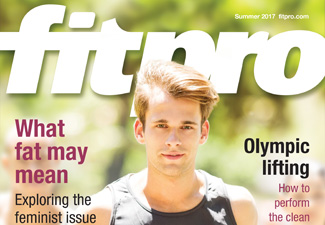Magazine References
Summer 2017

The Fitness word with Tony Lycholat
References
- Kruger, J. and Dunning, D. (1999) Unskilled and unaware of it: difficulties in recognising one’s own incompetence lead to inflated self-assessments, J. Personality and Social Psych., 77(6):1121-1134.
- Earp, B.D. (2016) The unbearable asymmetry of bullshit, Healthwatch, 101: 4-5.
- Pennycook, G. et al (2015) On the reception and detection of pseudo-profound bullshit, Judgement and Decision Making, 10(6):549-563.
- https://en.wikipedia.org/wiki/Alternative_facts
- https://www.painscience.com/articles/does-fascia-matter.php
- https://www.anatomytrains.com/news/2015/11/07/biomechanical-auto-regulation/
Did you hear me?
References
- Merrill, D. and Reid, R. (1981) Social Style Inventory, Personal Styles and Effective Performance
What fat may mean
Recommended reading
- BBC (2016) Body Image, a problem for boys, says advertising think tank, last accessed: 8 March 2017, bbc.co.uk/news/education-37010205
- Schilder, P. (1950) The Image and Appearance of the Human Body, p11, Abingdon, Routledge.
- National Centre for Eating Disorders (2012) Body Image, last accessed: 11 April 2017, http://eating-disorders.org.uk/information/body-image/
- Orbach, S. (1993) Body Image: Understanding body dissatisfaction in men, women and children, Chapter 2, Abingdon, Routledge.
- Orbach, S. (1982) Fat Is a Feminist Issue, 5: 238-245.
- AnyBody (2006) Exercise 1: Fat Fantasy, last accessed: 11 April 2017, any-body.org/cyber_psychologist/2006/3/23/exercise-1-fat-fantasy.html#comments
Movement assessment and screening
References
- Renstrom, P.A.F.H (1993) Sports Injuries: basic principles of prevention and care, IOC Medical Commission Publication, Blackwell Scientific Publications.
- Roitman, J.L. (2001) ACSM’s Resource Manual for Guidelines for Exercise Testing and Prescription,4th Ed., ACSM, Lippincott, Williams and Wilkins.
- Brown, L.E. et al (2000) Training for speed, agility and quickness, Human Kinetics.
- Magee, D.J. (1992) Orthopaedic Physical Assessment,2nd Ed.,WB Saunders.
- Australian Sports Commission (2000) Physiological Tests for Elite Athletes, Human Kinetics.
- Kendall, F.P. and McCreary, E.K. (1983) Muscles: Testing and Function, Williams and Wilkins.
- Sahrmann, S. (2002) Diagnosis and Treatment of Movement Impairment Syndromes, Mosby.
- Doherty, M. et al (1992) The GALS locomotor screen, Annals of the Rheumatic Diseases, 51:1165-1169.
- Cook, G. and Burton, L. The Functional Movement Screen, www.performbetter.com.
- Lycholat, T. (2016) Evidence Based Practice in the Fitness Industry, FitPro, Summer 2016.
- Lisman, P. et al, (2012) Functional Movement Screening and aerobic fitness predict injuries in military training, Med. Sci. Sports Exerc.published ahead of print, 27 November 2012.
- O’Connor, F.G. et al (2011) Functional Movement Screening: predicting injury in officer candidates, Med. Sci. Sports Exerc.43(12):2224-2230.
- Beardsley, C. and Contreras, B. (2014) The Functional Movement Screen: a review, J Strength Cond. Rev., 36(5):72-80.
- Bosch, F. and Klomp, R. (2001) Running: biomechanics and exercise physiology applied in practice. Elsevier.
- Richardson, C. et al (1999) Therapeutic Exercise for Spinal Segmental Stabilisation in Low Back Pain. Churchill Livingstone.
- Nilstad, A. et al (2011) A simple clinical screening test can identify elite female football players with increase knee valgus angles, Br J Sports Med., 45:310, doi:10.1136/bjsm.2011.084038.1.
- Williams, K., Steinberg, L. and Petronis, J. (2003) Therapeutic Application of Iyengar Yoga for healing chronic low back pain, Int. J. Yoga Therapy, 13:55-67.
Green exercise
Reference
- Thompson Coon, J, Boddy, K, Stein, K, Whear, R, Barton, J, Depledge, M.H. (2011) Does participating in physical activity in outdoor natural environments have a greater effect on physical and mental wellbeing than physical activity indoors? A systematic review, Environmental Science and Technology, 45(5):1761-1772.
- Pretty, J, Peacock, J, Sellens, M, Griffin, M. (2005) The mental and physical health outcomes of green exercise, International Journal of Environmental Health Research, 15(5):319-337.
- Brymer, E, Davids, K. (2014) Experiential learning as a constraint-led process: an ecological dynamics perspective, Journal of Adventure Education and Outdoor Learning, 14(2):103-117.
- Brymer, E, Davids, K. (2012) Ecological dynamics as a theoretical framework for development of sustainable behaviours towards the environment, Environmental Education Research, 19(1):45-63.
- Rogerson, M, Barton, J. (2015) Effects of the Visual Exercise Environments on Cognitive Directed Attention, Energy Expenditure and Perceived Exertion, International Journal of Environmental Research and Public Health, 12(7):7321-7336.
- Van den Berg, A.E, Hartig, T, Staats, H. (2007) Preference for nature in urbanized societies: Stress, restoration, and the pursuit of sustainability, Journal of Social Issues, 63(1):79-96.
- Focht, B.C. (2009) Brief walks in outdoor and laboratory environments: effects on affective responses, enjoyment, and intentions to walk for exercise, Research Quarterly for Exercise and Sport, 80(3):611-620.
- Ceci, R, Hassmén, P. (1991) Self-monitored exercise at three different RPE intensities in treadmill vs field running, Medicine and Science in Sports and Exercise 23(6):732-738.
- Rogerson, M. (2017) Commentary: Environmental Influences on Elite Sport Athletes Well Being: From Gold, Silver, and Bronze to Blue, Green and Gold, Frontiers in Psychology, 8(78).
- Li, Q, Otsuka, T, Kobayashi, M. et al (2011) Acute effects of walking in forest environments on cardiovascular and metabolic parameters, European Journal of Applied Physiology, 111(11):2845-2853.
- Brown, D.K, Barton, J.L, Gladwell, V.F. (2013) Viewing nature scenes positively affects recovery of autonomic function following acute-mental stress, Environmental Science and Technology, 47(11):5562-5569.
- Brown, D.K, Barton, J.L, Pretty, J, Gladwell, V. (2014) Walks4Work: Assessing the role of the natural environment in a workplace physical activity intervention, Scand J Work Environ Health 40(4):390-399.
- Gladwell, V.F, Brown, D.K, Wood, C, Sandercock, G.R, Barton, J.L. (2013) The great outdoors: how a green exercise environment can benefit all, Extreme Physiology and Medicine, 2(1):1-7.
- Gladwell, V.F, Kuoppa, P, Tarvainen, M.P, Rogerson, M. (2016) A Lunchtime Walk in Nature Enhances Restoration of Autonomic Control during Night-Time Sleep: Results from a Preliminary Study, International Journal of Environmental Research and Public Health, 13(3):280.
- Li, Q, Morimoto, K, Nakadai, A. et al (2007) Forest bathing enhances human natural killer activity and expression of anti-cancer proteins, International Journal of Immunopathology and Pharmacology, 20(2 suppl):3-8.
- Lee, J, Li, Q, Tyrväinen, L. et al (2012) Nature therapy and preventive medicine, Public Health-Social and Behavioral Health, 16:325-350.
- Rogerson, M, Gladwell, V.F, Gallagher, D.J, Barton, J.L. (2016) Influences of Green Outdoors versus Indoors Environmental Settings on Psychological and Social Outcomes of Controlled Exercise, International Journal of Environmental Research and Public Health, 13(4):363.
The plasticity of ageing
References
- Manini TM and Clark BC. Dynapenia and aging: An update. J Gerontol A Biol Sci Med Sci (2012) Jan;67A(1):28-40.
- Fiatarone MA, Marks EC, Ryan ND, Meredith CN, Lipsitz LA and Evans WJ. High-intensity strength training in nonagenarians. Effect on skeletal muscle. JAMA (1990) June 13;263(22):3029-34.
- Fiatarone MA, O’Neill EF, Ryan ND, Clements KM, Solares GR, Nelson ME, Roberts SB, Kehayias JJ, Lipsitz LA and Evans WJ. Exercise training and nutritional supplementation for physical frailty in very elderly people. NEJM (1994) June 23;330(25):1769-75.
- Rice J and Keogh JWL. Power training: Can it improve functional performance in older adults? A systematic review. Int J Exerc Sci (2009); 2(2):131-151.
- Sayers SP. High velocity power training in older adults. Current Aging Science (2008);1:62-67
- Chodzko-Zajko WJ, Proctor DN, Fiatarone-Singh MA, Minson CT, Nigg CR, Salem GJ and Skinner JS. Exercise and physical activity for older adults. MSSE (2009) July;41(7):1510-30.
- https://www.alz.co.uk/research/WorldAlzheimerReport2015.pdf
- Bamidis PD, Vivas AB, Styliadis C, Frantzidis C, Klados M, Schlee W, Siountas A and Papageorgiou SG. A review of physical and cognitive interventions in aging. Neuroscience and Biobehavioral Reviews 44 (2014); 206-220
- Ballesteros S, Kraft E, Santana S and Tziraki C. Maintaining older brain functionality: A targeted review. Neuroscience and Biobehavioral Reviews 55 (2015); 453-477.
- Hotting K and Roder B. Beneficial effects of physical exercise on neuroplasticity and cognition. Neuroscience and Biobehavioral Reviews 37 (2013); 2243-2257.
- Szuhany KL, Bugatti M and Otto MW. A meta-analytic review of the effects of exercise on brain-derived neurotrophic factor. J Psychiatr Res (2015) January;60:56-64.
All about protein
References
- Campbell, B.I. and Spano, M.A. (2011) NSCAs Guide to Sport and Exercise Nutrition, National Strength and Conditioning Association, Human Kinetics.
- Kato, H. et al (2016) Protein requirements after exercise as determined by the indicator amino acid oxidation method, PLOS ONE, , DOI:10.1371/journal.pone.0157406.


